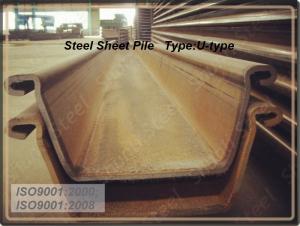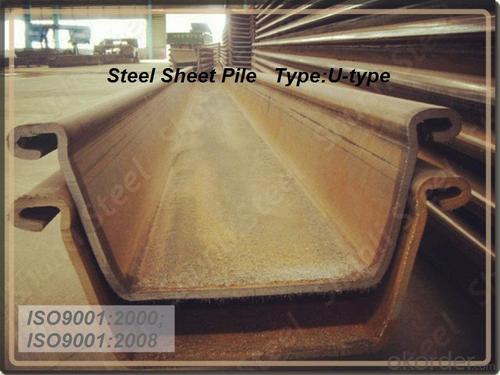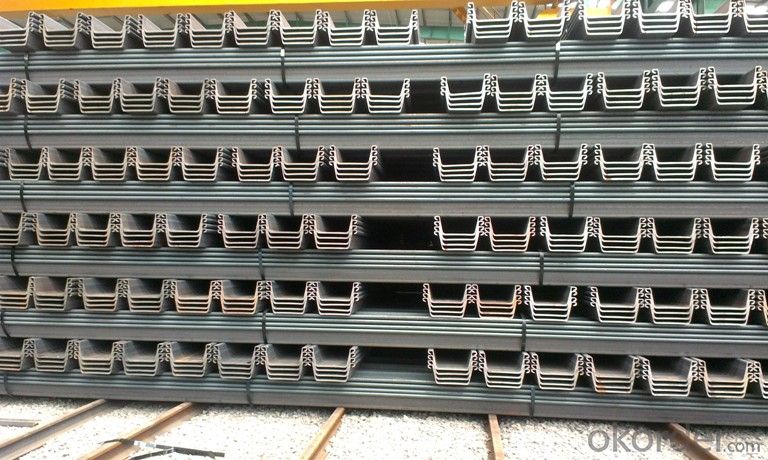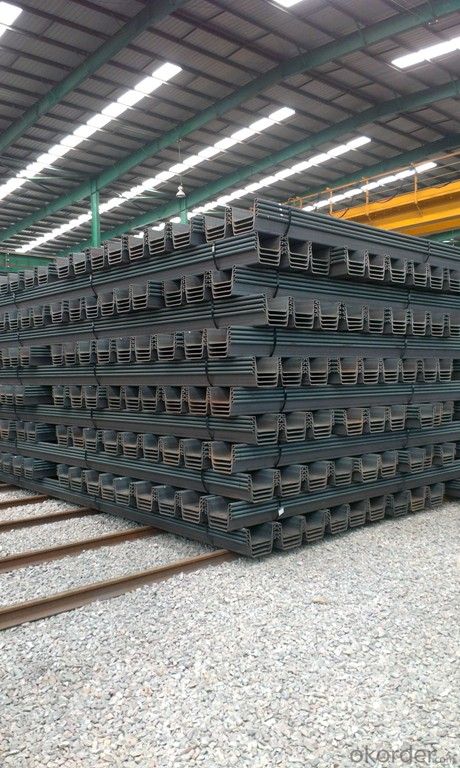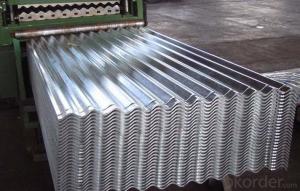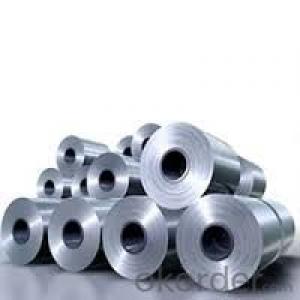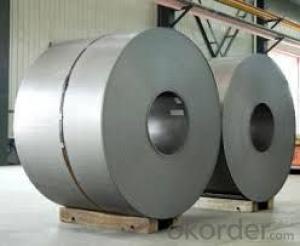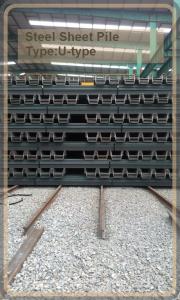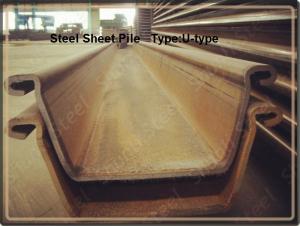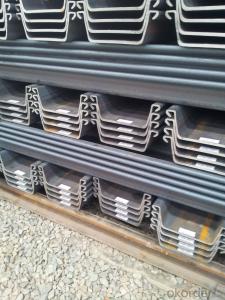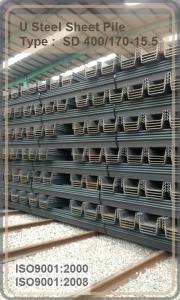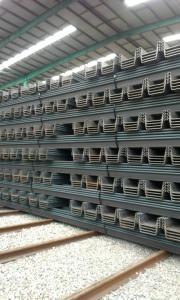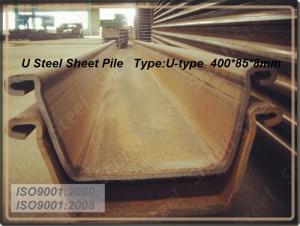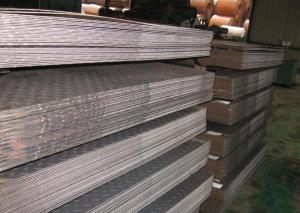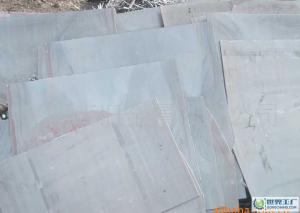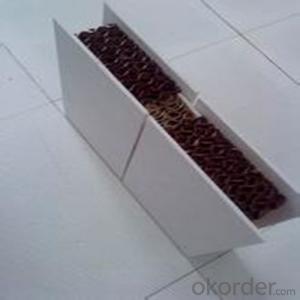U Steel Sheet Pile 500*200*24.3mm
- Loading Port:
- China Main Port
- Payment Terms:
- TT or LC
- Min Order Qty:
- 200 Piece/Pieces m.t.
- Supply Capability:
- 10000 m.t./month
OKorder Service Pledge
OKorder Financial Service
You Might Also Like
Quick Details for Steel Sheet Piles
Place of Origin: China (Mainland)
Model Number: SD500/200-24.3
Material: Steel
Product name: Steel Sheet Pile
Steel sheet pile type: U-type
Steel sheet pile material: SY295
Steel sheet pile width: 500mm
Steel sheet pile height: 200mm
Steel sheet pile thickness: 24.3mm
Steel sheet pile length: 6m or 12m
Steel sheet pile loading: container , 20 ft or 40GP
Steel sheet pile used: temporary earth-retaining,temporary cofferdam works
Steel sheet pile weight: 105kgs / m
Packaging & Delivery
| Packaging Details: | packaging :by bulk . loading : container 20ft or 40GP |
|---|---|
| Delivery Detail: | stock ( more type has stock ) |
Export U Steel Sheet Pile 500*200*24.3mm
Product Description
Steel Sheet Pile Usage
temporary earth-retaining, temporary cofferdam works and permanent structures
Steel Sheet Pile Type : SD 500/200-24.3
Type | Size | Per piece | Per Meter of pile wall | ||||||||
Width | Height | Thickness | weight | section area | section moment | section modulus | section area | section moment | section modulus | weight | |
mm | mm | mm | kgs /m | cm2 | cm4 | cm3 | cm²/m | cm4/m | Cm³/m | kg/m² | |
SD500/200-24.3 | 500 | 200 | 24.3 | 105 | 133.8 | 7960 | 520 | 267.6 | 63000 | 3150 | 210 |
SD500/225-27.6 | 500 | 225 | 27.6 | 120 | 153 | 11400 | 680 | 306 | 86000 | 3820 | 2 |
Packaging & Shipping
Packing : it use container to load , 6M use 20ft container ; 12M use 40GP container .
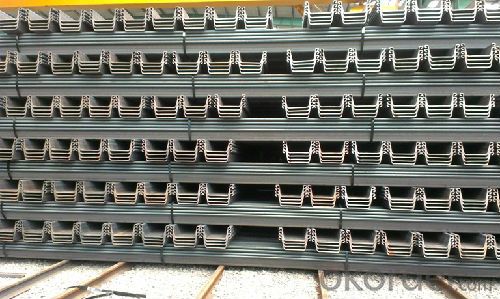
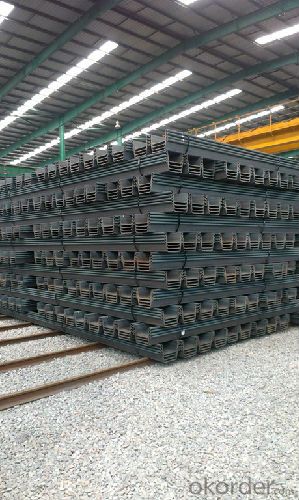

Our Services
World leading manufacturer of cold-formed Sheet Pile.
Factory got a variety of quality certification : ISO9001:2000; ISO9001:2008.
Our products popular applicated for temporary earth-retaining, temporary cofferdam works and permanent structures
- Q: How do steel sheets perform in high-humidity environments?
- Due to their inherent properties, steel sheets typically exhibit excellent performance in environments with high humidity. Steel is renowned for its strength, durability, and resistance to corrosion, rendering it a suitable material for enduring conditions characterized by excessive moisture. In certain materials, the presence of high humidity can result in the development of condensation on surfaces, thereby accelerating the corrosion process. However, steel sheets are often endowed with protective layers such as zinc or other corrosion-resistant coatings. These coatings function as a barrier against moisture, effectively preventing the onset of rust. Moreover, steel sheets are frequently subjected to galvanization or treatment with specialized coatings like stainless steel or weathering steel. These measures serve to enhance their resistance to humidity and forestall degradation over time. By providing an additional layer of protection, these coatings ensure that steel sheets retain their structural integrity and continue to perform well even in environments with high humidity. It is worth emphasizing that while steel naturally possesses resistance to moisture, the implementation of proper maintenance and care remains crucial to ensure its long-term performance. Regular inspections, cleaning, and the application of suitable sealants or coatings, if necessary, can further fortify steel sheets against the challenges of high humidity. In conclusion, steel sheets are generally well-suited for high-humidity environments due to their strength, durability, and corrosion resistance. Through the application of appropriate coatings and diligent upkeep, steel sheets can uphold their performance and structural integrity even in conditions characterized by an abundance of moisture.
- Q: Can steel sheets be used for signage or advertising displays?
- Yes, steel sheets can be used for signage or advertising displays. Steel is a durable and versatile material that can be shaped, cut, and painted to create attractive and long-lasting signs and displays. Additionally, steel sheets can withstand outdoor conditions, making them suitable for both indoor and outdoor advertising purposes.
- Q: What is the average wind load capacity of steel sheets?
- The average wind load capacity of steel sheets can vary depending on various factors such as sheet thickness, size, shape, and the specific steel material used. It is typically determined by conducting engineering calculations and considering local building codes and standards. Therefore, it is not possible to provide a specific average wind load capacity without knowing the specific details of the steel sheets in question.
- Q: Can steel sheets be used for toolboxes and cabinets?
- Yes, steel sheets can be used for toolboxes and cabinets. Steel is a durable and sturdy material that can withstand heavy loads and provide excellent protection for tools and items stored inside. It is commonly used in the construction of toolboxes and cabinets due to its strength and ability to resist damage from impact and corrosion.
- Q: How are steel sheets joined together?
- Steel sheets can be joined together through various methods such as welding, riveting, bolting, or using adhesives.
- Q: What are the different methods of protecting steel sheets from scratches?
- There are several methods of protecting steel sheets from scratches. One common method is applying a protective coating or paint on the surface of the steel sheet. This coating acts as a barrier and prevents scratches from occurring. Another method is using a temporary protective film or tape on the steel sheet. This film or tape can be easily applied and removed, providing a temporary safeguard against scratches. Additionally, using padded or protective packaging during transportation or storage can help prevent scratches. Implementing proper handling and storage procedures, such as using non-abrasive materials and avoiding stacking or sliding steel sheets, can also minimize the risk of scratches.
- Q: What is the thickness range of steel sheets?
- The thickness range of steel sheets can vary depending on the specific type and intended use, but it generally ranges from around 0.4 millimeters to 6 millimeters.
- Q: Can the steel sheets be easily engraved or etched?
- Engraving or etching steel sheets is a widely adopted practice across several industries, including automotive, aerospace, and jewelry. It involves employing specialized tools and techniques to craft intricate designs, patterns, or text on the surface of the steel sheets. The hardness and durability of steel make it an ideal material for engraving, as it can withstand the pressure and cutting force necessary for creating detailed engravings. Furthermore, the sleek surface of steel sheets ensures precise and unclouded etching outcomes. Nevertheless, it is crucial to acknowledge that the ease of engraving or etching may vary depending on the specific type and grade of steel employed.
- Q: Are steel sheets suitable for architectural cladding?
- Yes, steel sheets are suitable for architectural cladding. Steel cladding offers durability, strength, and versatility in design, making it a popular choice for architects. It can be easily formed into different shapes and sizes, providing flexibility in creating unique building facades. Additionally, steel cladding is resistant to weather conditions, fire, and pests, making it a long-lasting and low-maintenance option for architectural applications.
- Q: What is the difference between a hot rolled and cold rolled stainless steel sheet?
- The main difference between a hot rolled and cold rolled stainless steel sheet lies in the production process. Hot rolled stainless steel sheets are made by heating a stainless steel slab above its recrystallization temperature and then rolling it through a series of rollers until the desired thickness is achieved. This process results in a rough, scaled surface with a characteristic oxide layer. On the other hand, cold rolled stainless steel sheets are produced by further processing the hot rolled sheets. The hot rolled sheets are first annealed, which involves heating them and then cooling them slowly to regulate the microstructure and remove any stresses. After annealing, the sheets are cold rolled, which means they are passed through a set of rollers at room temperature to achieve the desired thickness. This process results in a smoother, more refined surface with improved mechanical properties. In summary, hot rolled stainless steel sheets have a rough surface and are less precise in terms of thickness, while cold rolled stainless steel sheets have a smoother surface and are more precise in terms of thickness. Cold rolled sheets also tend to have better mechanical properties due to the additional processing steps involved.
Send your message to us
U Steel Sheet Pile 500*200*24.3mm
- Loading Port:
- China Main Port
- Payment Terms:
- TT or LC
- Min Order Qty:
- 200 Piece/Pieces m.t.
- Supply Capability:
- 10000 m.t./month
OKorder Service Pledge
OKorder Financial Service
Similar products
Hot products
Hot Searches
Related keywords
